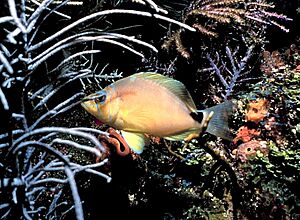Butter hamlet facts for kids
Quick facts for kids Butter hamlet |
|
|---|---|
 |
|
| Conservation status | |
| Scientific classification | |
| Synonyms | |
|
Perca unicolor Walbaum, 1792 |
The butter hamlet or yellowtail hamlet (scientific name: Hypoplectrus unicolor) is a type of ray-finned fish that lives in the ocean. It's a kind of sea bass and belongs to the same family as groupers. You can find this fish in the western central Atlantic Ocean. Sometimes, people keep them in aquariums.
Contents
What Does It Look Like?
The butter hamlet has a body that is quite deep and flat from side to side. Its head is also flat. It has a straight forehead and a short nose. Its upper jaw can stick out.
The fin on its back, called the dorsal fin, has ten strong spines and 14 to 17 soft rays. Its long fins on the belly, called pelvic fins, can reach past its bottom opening. The tail fin, or caudal fin, is slightly split.
This fish is usually greyish-white to yellow. Its back is darker. It has a big black mark near its tail that looks like a saddle. This mark goes over the lateral line on both sides. Bright blue lines run across its head. Sometimes, these lines go all the way to its pelvic fins. There's also a clear blue line around its eye. Some butter hamlets might have two black spots on their nose.
Its pelvic fins are yellowish, but its chest fins, called pectoral fins, are clear. The butter hamlet can grow up to about 12.7 centimeters (5 inches) long.
Where Does It Live?
The butter hamlet lives in the western Atlantic Ocean. You can find it from Cape Canaveral in Florida down to the Bahamas. It also lives in the Gulf of Mexico, near places like Cedar Key and the coast of Mexico. It's also found from northwestern Cuba through the Caribbean Sea.
Its Home and How It Lives
You can find butter hamlets on shallow coral reefs, on the front slopes of reefs, and under piers. They usually live at depths between 3 and 25 meters (10 to 82 feet).
What It Eats
This fish is a carnivore, meaning it eats other animals. Its diet mainly includes crustaceans (like crabs and shrimp) and smaller fish. Young butter hamlets are often seen living in mangroves.
How It Reproduces
Fish in the Hypoplectrus group, including the butter hamlet, are special. They are hermaphrodites, which means they have both male and female parts at the same time. When they spawn (lay eggs), they can switch between being a "male" or a "female."
Mimicry and Other Fish
Scientists have thought that the butter hamlet might be a mimic of the foureye butterflyfish (Chaetodon capistratus). This idea came from how similar they look and how they live in the same shallow water areas. The butter hamlet eats moving animals that live on the seabed, while the butterflyfish eats animals that stay in one place.
However, the butter hamlet's colors and patterns change depending on where it lives, but the butterflyfish's don't. Also, their young fish don't look alike. Even so, there is a connection between them. Butter hamlets that follow feeding butterflyfish are better at catching their own food than hamlets that don't.
History of Its Name
The butter hamlet was first officially described in 1792. It was named Perca unicolor by a German doctor and scientist named Johann Julius Walbaum.
People and the Butter Hamlet
The butter hamlet is sometimes kept in aquariums. It's one of the most popular types of hamlet fish for people to keep as pets. It has also been raised in captivity.


